Science Daily News | 09 Jun 2023

Views (186)
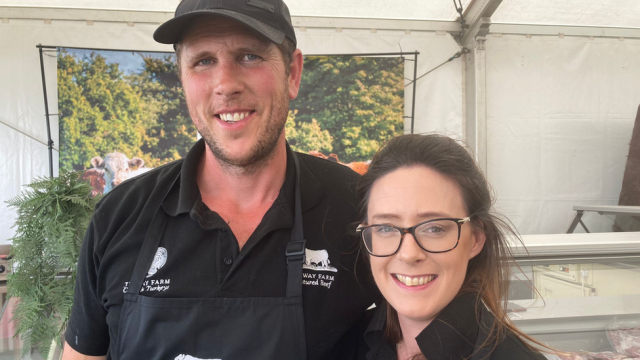
Smoke brings a warning: There's no escaping climate's threat to health
The cloud of smoke inundating the East Coast on Wednesday - fueled by more than 400 active fires burning across Canada, with more than half of them considered "out of control" - underscored how climate change's threat to human health can transcend national boundaries. Dozens of East Coast counties issued health warnings as air-quality measures hit their worst marks in years, or even decades, prompting many elderly Americans and schoolchildren to shelter inside.Subscribe to The Post Most newslett
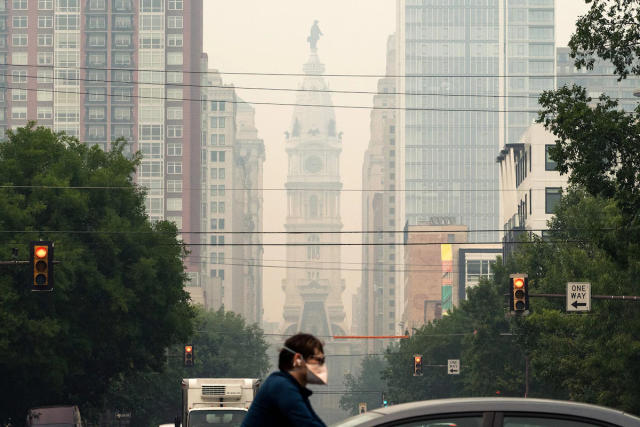
The cloud of smoke inundating the East Coast on Wednesday - fueled by more than 400 active fires burning across Canada, with more than half of them considered "out of control" - underscored how climate change's threat to human health can transcend national boundaries.
Dozens of East Coast counties issued health warnings as air-quality measures hit their worst marks in years, or even decades, prompting many elderly Americans and schoolchildren to shelter inside.
The shroud above the Northeast prompted public health authorities to convene emergency meetings, hospitals to prepare for a possible uptick in patients and lawmakers to again call for legislation to tamp down the risks of a warming world. The acute public health threat posed by the fumes, which carry dangerous gases and fine particles that can embed in people's lungs and bloodstream, coupled with the transformation of major cities' skylines punctured many Americans' sense of invulnerability.
"Climate change is real. It is here. The extreme weather and disasters like these wildfires, thousands of miles away, land right here in our great city and impact our health," New York City Health Commissioner Ashwin Vasan said at a news conference Wednesday morning, urging residents to stay indoors, wear masks if needed outdoors and take other precautions. City officials said the air was the worst in more than 50 years - with an Air Quality Index score Wednesday that at one point reached 484, signifying "hazardous" conditions - and would likely last several days.
Wildfire smoke has posed a growing health risk in the United States for years, with Western states repeatedly reeling from fires and residents attempting to cope by purchasing personal air filters, staying indoors and adopting other ad hoc solutions. In interviews on Wednesday, federal experts touted guidance from the Centers for Disease Control and Prevention on how to stay safe. But the smoke enveloping the East Coast arrives at a moment when many Americans have tuned out warnings from public health officials in the wake of the coronavirus pandemic. Many people in affected areas continued their usual routines despite the intense haze, scratchy throats and other manifestations of the smoky conditions.
Jackie Dehart, who works at a coffee shop in the Flatiron District in Manhattan, said that she had seen many customers lingering in the shop's outdoor seating area. "It feels apocalyptic," said Dehart about the orange-ish smoke. "But a friend eased my fears when they told me that forest fires are natural and good for the forests."
Health officials stressed that wildfire smoke should not be inhaled by anyone and could lead to short- and long-term complications. Officials said they were most worried about vulnerable groups such as people with lung disease, diabetes or Alzheimer's or who are pregnant.
"These particles cause inflammation in the lungs, but they also pass through into the bloodstream. They embed themselves in the walls of our blood vessels, and they still have inflammation there as well," said John Balbus, the acting director of the Office of Climate Change and Health Equity at the Department of Health and Human Services. "For somebody who has really bad heart disease, they can trigger a heart attack - but for everybody, they can lead to inflammation and increase the threat of what we call atherosclerosis, of hardening of the arteries."
The warnings were echoed at the U.S. Capitol, where lawmakers said they shared public health experts' concerns and called for legislation to combat climate change.
"I urge every single American and Canadian impacted by the smoke to take precautions to stay safe and follow public health guidelines in their communities," Senate Majority Leader Charles E. Schumer (D-N.Y.) said on the Senate floor.
It may take time to fully understand the impact of the current smoke cloud on the Eastern Seaboard, said Aaron Bernstein, a physician who leads the CDC's center for environmental health.
"When you breathe in wildfire smoke, you can get sick on the same day - many people do," Bernstein said. "But we absolutely do see effects several days [later] after people breathe it."
The smoke plaguing the Eastern United States has been sparked by devastating blazes that have upended life from coast to coast in Canada, swallowing homes and other structures, and forcing more than 100,000 people in nine of the country's 13 provinces and territories from their homes since early May, according to officials from Natural Resources Canada.
As of Wednesday, more than 2,200 wildfires had burned so far this year, according to Canadian officials. In the Atlantic province of Nova Scotia, unusually intense blazes this year have already scorched more land than has been burned in the last 10 years combined.
"This is a scary time for a lot of people," Canadian Prime Minister Justin Trudeau told reporters at a news conference on Monday, promising to do "whatever it takes to keep people safe."
If fire activity continues at the current pace, Canadian officials said this week, scientific modeling shows that Canada is on track to experience the worst wildfire season in its recorded history.
"People have said, 'Well, it's a new normal.' No, there is no such thing as a new normal," said Werner Kurz, senior research scientist with Natural Resources Canada. "The only thing that's normal right now is that with climate change the situation is going to get progressively worse."
The Canadian fires have also spawned some of the smokiest conditions in cities such as New York, Detroit and elsewhere that have been seen over the past two decades, said Marshall Burke, an associate professor in the Department of Earth System Science at Stanford University.
Scientists have detailed how a warming world can fuel more - and more intense - fires. The Intergovernmental Panel on Climate Change, a group of some of the planet's foremost researchers, has said that unless humans drastically reduce the burning of fossil fuels, wildfire seasons are likely to grow longer and that more area will burn.
Lisa Patel, executive director of the Medical Society Consortium on Climate and Health, which raises awareness about the health effects of climate change, said at the current rate, wildfire smoke could be the predominant form of air pollution many humans breathe by the end of the century.
"This is a reminder of what many of us in the health world have been saying for a long time: Climate change is going to affect all of us," she said.
West Coast-based officials said that images of the smoke-shrouded East Coast felt disturbingly familiar.
"A lot of us are remarking on that it's [like] a transformational day in San Francisco three years ago, when it never got light . . . [and] felt like being on the on the surface of Mars," said Wade Crowfoot, California's natural resources secretary.
In New York City, physicians grappled with the eerie sensation of being in a dust bowl. Ronald Crystal, a pulmonologist at Weill Cornell Medicine in New York City, said he could "barely see" nearby buildings out of his office window, and he was worried about the health effects of the bad air on some of his patients.
Experts on Wednesday said they were encouraging many of the same tactics that were recommended to fight the coronavirus pandemic, such as filtering the air indoors and wearing well-fitting masks as needed.
"A lot of the covid recommendations hold in this situation as well," said Peter DeCarlo, an associate professor of environmental health and engineering at Johns Hopkins University, although he noted that Americans in areas affected by wildfire smoke should keep their homes' windows and doors closed, rather than air them out, as experts encouraged them to do to reduce covid risks. DeCarlo also suggested that people in cars keep their windows closed and recirculate the air in hopes of removing particles through the car's air filters.
The experts acknowledged that some Americans had grown skeptical of public health advice in the wake of the covid outbreak.
"It's unfortunate a mask became so politicized during the pandemic," said Linsey Marr, an environmental engineer at Virginia Tech. "A good-quality mask . . . will definitely protect your health and reduce your exposure."
Marr said that a mask could help remove particles from the air but cautioned that it could not stop all "smelly gases," which is why some people "may still smell smoke" even when wearing a well-fitting, high-quality face covering.
"The mask needs to allow . . . oxygen to get through so you can breathe the air. But that doesn't mean it's not working," she said.
Lauren Cohen was one of those masked New Yorkers. She is 28 weeks pregnant, and her doctor advised her to wear a mask and not attend the Yankees game Wednesday night - a game later postponed.
"The world is burning, like this is not good, we need to pay attention to climate change and all of the things that are causing this," Cohen, 40, said. "It truly felt, like, apocalyptic last night, and it was like a glimpse into, if we don't do anything, then this is what the world is going to look like."
- - -
The Washington Post's Amanda Coletta contributed to this report.
Related Content
Firefly Aerospace acquires Spaceflight Inc. to boost capabilities for on-orbit services
Texas-based Firefly Aerospace says it has acquired Bellevue, Wash.-based Spaceflight Inc. and will shift the operation’s focus from satellite rideshare logistics to its line of orbital transfer vehicles. Firefly says the strategic acquisition will add to its portfolio of low-cost space transportation services, ranging from launch vehicles to its Blue Ghost lunar lander. “Spaceflight’s flight-proven orbital vehicles, facilities and mission management expertise will support Firefly’s rapid growth,
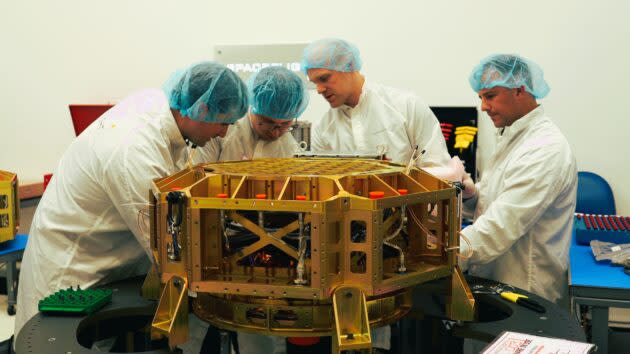
Firefly says the strategic acquisition will add to its portfolio of low-cost space transportation services, ranging from launch vehicles to its Blue Ghost lunar lander.
Financial terms of the transaction were not disclosed.
Spaceflight will now fall under the Firefly Aerospace brand, said Risa Schnautz, Firefly’s senior manager for marketing and communications. The entire Spaceflight team will be joining Firefly, and Schnautz said the team’s talents, roles and responsibilities will be assessed in the months ahead.
“Firefly’s plan is to utilize Spaceflight’s Bellevue facilities to manufacture its orbital vehicles,” Schnautz told GeekWire in an email. “Our Blue Ghost lunar lander will continue to be manufactured at our facility in Cedar Park, Texas.”
Spaceflight’s Sherpa orbital transfer vehicles are designed to be launched on rockets including SpaceX’s Falcon 9. Multiple satellites can be attached to a single Sherpa, and then deployed into a variety of orbits after the orbital tug separates from its launch vehicle.
In addition to building Sherpas, Spaceflight Inc. has handled pre-launch arrangements for satellites on rideshare missions. But Schnautz said that part of the business will be de-emphasized.
“We’re currently assessing the needs of our combined customers to meet their mission requirements with Firefly’s launch vehicles,” Schnautz said. “Firefly will honor Spaceflight’s current contracts but will not be aggregating payloads on other launch vehicles moving forward.”
Weber said the acquisition of Spaceflight Inc. “is the result of Firefly’s business plan to strengthen the company through organic growth in addition to accelerating its capabilities with strategic acquisitions.”
Firefly’s Alpha launch vehicle is manifested through 2023 with the U.S. Space Force, NASA and other commercial customers. The company is also developing a new medium-lift launch vehicle in collaboration with Northrop Grumman. Firefly’s Blue Ghost lunar lander is due to complete the first of two planned missions to the moon next year with NASA as the anchor customer, and Firefly’s Space Utility Vehicle has a mission scheduled early next year to demonstrate the vehicle’s on-orbit capabilities.
“The combination of Spaceflight’s on-orbit experience with Firefly’s launch vehicles, Blue Ghost landers, and Space Utility Vehicles is an overnight game changer for our customers and investors,” Weber said.
As winter warms, farmers in southern US find ways to adapt
When Pam Knox walked into the peach orchard at the University of Georgia horticulture farm this spring, there was nothing on the trees except leaves and a couple of brown fruits — the result of one of the state's warmest winters ever followed by two nights of freezing weather in March. “It’s just really odd, because over the course of one night, they lost their entire crop and their entire production here,” said Knox, an agricultural climatologist with the University of Georgia Cooperative Extension, which shares research and expertise with farmers and others. Commercial peach farmers in the state lost as much as 95% of their yield, she estimated.
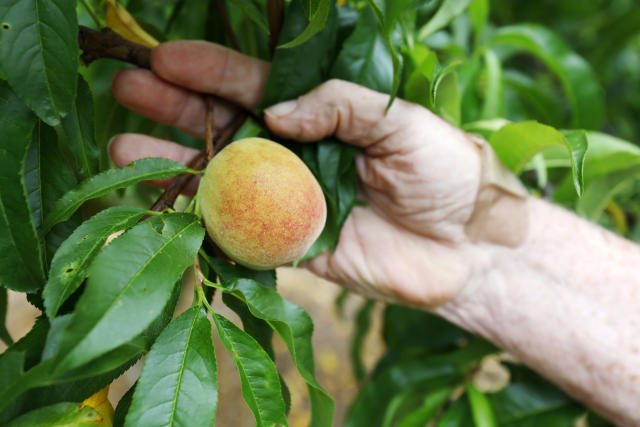
When Pam Knox walked into the peach orchard at the University of Georgia horticulture farm this spring, there was nothing on the trees except leaves and a couple of brown fruits — the result of one of the state's warmest winters ever followed by two nights of freezing weather in March.
“It’s just really odd, because over the course of one night, they lost their entire crop and their entire production here,” said Knox, an agricultural climatologist with the University of Georgia Cooperative Extension, which shares research and expertise with farmers and others. Commercial peach farmers in the state lost as much as 95% of their yield, she estimated.
Georgia, with its iconic peaches, isn’t the only place in the south where farmers have had to deal with changing conditions. Houston, Tupelo and Atlanta all had one of their top five warmest winters on record this year, according to the National Centers for Environmental Information. Farmers are contending with those warming winters by using new or improved agricultural techniques, trying out new crop varieties and even growing crops that were previously less common in their regions.
Cody Mills, an extension agent and Chickasaw County coordinator at Mississippi State University, said a warmer and wetter winter delayed some farmers from planting corn and some soybeans because they had to wait for drier weather. A couple weeks might not seem like a long time, he said, but that can set back cutting and harvesting later.
Cattle ranchers have been affected, too. Mills said that the pathogens associated with a wet winter – as well as the mud – took a toll on some cows. Wetter, warmer weather creates better conditions for the pathogens and parasites that cause cows to develop conditions like foot rot, pinkeye and diarrhea, said Russ Daly, an extension veterinarian with South Dakota State University.
In Texas, the warm weather presented more of a mixed bag for cattle farmers, said David Anderson, a professor and extension economist at Texas A&M University. He said drought conditions have meant higher hay costs, but farmers have needed less of it since cows eat less in hotter weather.
Farmers have always adapted to changing weather. Now they're adapting to climate change.
For example, some fruit growers in Georgia are planting earlier-blooming peach varieties that don't require as much cold weather, Knox said. But it's not an easy calculation, because some of those earlier varieties may also be more susceptible to frost.
Farmers may also diversify their crops. Knox said some farmers in recent years have begun trying citrus and olives that are more often grown in climates with milder winters than Georgia's.
In Mississippi, some farmers have turned to corn varieties with a shorter growing season, Mills said. And researchers are working to improve vaccines against livestock conditions that can be made worse by a warming environment.
Taking good care of animals regardless of the changing conditions is paramount, said Brandi Karisch, an extension beef cattle specialist for Mississippi State University.
" ‘We’ve always done it that way’ is usually the death of a business, and you can see the same thing in the cattle world,” Karisch said. “We have to adapt to what the animals are telling us that they need and what we’re seeing from a climate and a system standpoint."
As they work to ensure the health of their crops and animals, farmers also “have to make sure that they make money, and you’re not going to invest in a crop that’s not going to succeed,” Knox said. But she doesn’t see the end of Georgia peaches anytime soon. Instead, she sees farmers considering which peach varieties they’ll be able to grow going forward and what other crops they can add to the mix.
“I think the farmers see the temperatures get(ting) warmer as an opportunity to increase the diversity of what they can grow,” Knox said. “They’re trying to figure out ways to respond to that and to take advantage of it.”
___
___
If a nuclear weapon is about to explode, here are 17 things you can do
Experts still believe a nuclear war is unlikely. But learning simple safety tips can save your life in case of the worst.
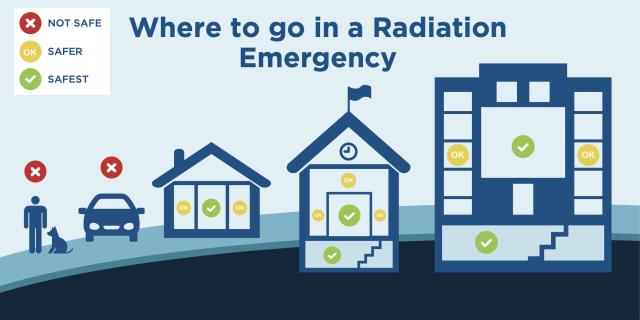
The threat of nuclear war, though distant, is prominent thanks to the invasion of Ukraine.
Nuclear weapons are deadly, but their worst effects are confined to a limited zone.
Here is how to best protect yourself in case of a nuclear blast, according to trusted sources.
"Knowing what to do after an event like this can literally save hundreds of thousands of people from radiation illness or fatalities."
Here are 17 tips to best protect yourself in case of an impact.
A bright flash caused by a huge fireball, which can cause temporary blindness
A blast wave, which can flatten buildings and cause serious injury and death. This wave can take several seconds to reach you.
A pulse of nuclear radiation.
Fire and heat, which can cause out-of-control fires.
An electromagnetic pulse, which can disable devices for miles around.
But the worst destruction, where the chances of survival are least likely, is confined to a "severe damage zone," Buddemeier said. For a 10-kiloton blast — equivalent to two-thirds of the Hiroshima bomb blast — that's about a half-mile radius.
There are ways to enhance your chance of survival in the unlikely scenario a nuclear bomb were to hit your town.
"There were survivors in Hiroshima within 300 meters [900 ft] of the epicenter," Buddemeier said.
If you receive notification of an imminent attack, your first priority is to seek shelter that will protect you both from bodily harm from the blast and from the radiation in the fallout that will follow.
If you're driving, pull over, get out, and make your way into a building, Buddemeier said.
Go as far underground as possible, per the Red Cross and FEMA. If that's not possible, try to stay in the center of the building, for example in a stairwell.
The deeper and lower in the building you can get and the farther from windows (which can shatter), doors (which can fly open), and exterior walls (which can cave in), the better your odds.
"I think of the same kinds of things that we do for tornadoes," Buddemeier said.
Don't look at the fireball, as the light could temporary blind you, per FEMA.
Stay tuned for more instructions. Mobile networks may be interrupted, but radios should still function, per FEMA.
Humans and pets should stay inside for at least 24 hours or until instructed otherwise by authorities, per the Red Cross.
If you're outside, your first priority is to shelter from the blast wave. Take cover behind anything that could protect you and lay flat on the ground and cover your head, per the Red Cross.
Don't assume the blast has passed you — it could take up to 30 seconds for the wave to reach you, per the Red Cross.
After the blast wave passes, you want to limit exposure to radiation.
If you're still outside, cover your mouth with a cloth or a towel, which can reduce the amount of radioactive fallout you breathe in, per the Red Cross.
Take shelter as soon as possible, regardless of how far you are from the impact. Radioactive fallout can travel hundreds of miles, per the Red Cross.
As soon as you are safely inside, remove the outer layer of your clothing.
If you were outside, you want to get the fallout as far away from your body as possible.
Removing your outer layer of clothing can reduce the amount of contamination from fallout by up to 90%, per the Red Cross.
If possible to do so safely, put all the contaminated clothing into a plastic bag that you keep far away from others and pets — the clothes may still be emitting radiation.
Wash your hair and skin with water and lots of soap and shampoo. Do not scratch the skin and do not use conditioner, which would bind any the radioactive material to your hair, per the Red Cross.
Gently blow your nose and wash out your ears, where contaminated dirt may be trapped, per the Red Cross.
A shower is best. If that's not available, a wet cloth wash will still help, provided the cloth hasn't been outside, per FEMA.
If your pet was outdoors, they could also be covered in fallout which could expose you and them. Gently brush your pet's coat then wash then with soap and water, per FEMA.
If you can, close windows and fireplaces, turn off fans, air conditioners, and forced-air heating units, per the Red Cross.
It's best to hunker down in your blast shelter if you're unsure whether it's safe to move.
At this point, fires and obstructive debris are likely to be widespread, Buddemeier said.
Eat and drink only packaged food items or items that were inside a building, per FEMA.
Care for your emotional wellbeing and the wellbeing of your children. Focus on positive actions you can take, limit exposure of children to media reports that can be scary, remember to eat and drink, and be patient with others, per the Red Cross.
"The most important thing in both cases is to be inside when the event occurs, either when the detonation occurs or when the fallout arrives," Buddemeier said.
This article was first published in January 2018 and has been updated to reflect recent developments. Dave Mosher contributed to the earlier version of the story.
Philippines raises alert level around volcano, villagers told to leave danger zone
Philippine officials on Thursday raised the alert level for one of the country’s most active volcanoes after superheated streams of gas, debris and rocks cascaded down its upper slope in a condition they fear could lead to a hazardous eruption within days or weeks. Villagers living within a 6-kilometer (3.7-mile) radius of Mayon volcano’s crater were told to leave the long-designated permanent danger zone and move to safer grounds due to the danger of volcanic emissions, lava flows, rockfalls and other hazards, officials said. Cedric Daep, a provincial public safety official, said villagers were preparing to evacuate from the danger zone, which is supposed to be off limits to permanent residents but where many mostly poor families have built houses in Mayon's shadow over the years.
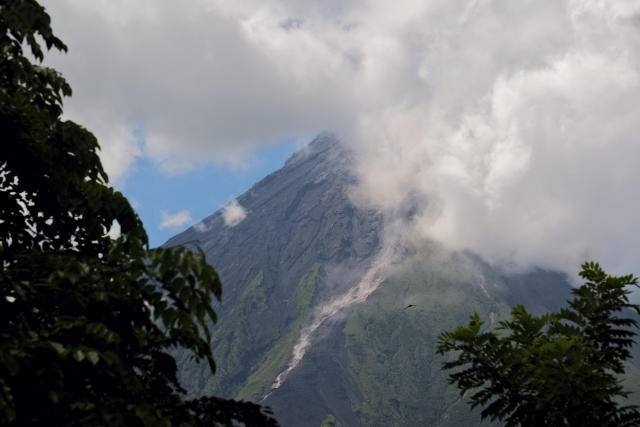
MANILA, Philippines (AP) — Philippine officials on Thursday raised the alert level for one of the country’s most active volcanoes after superheated streams of gas, debris and rocks cascaded down its upper slope in a condition they fear could lead to a hazardous eruption within days or weeks.
Villagers living within a 6-kilometer (3.7-mile) radius of Mayon volcano’s crater were told to leave the long-designated permanent danger zone and move to safer grounds due to the danger of volcanic emissions, lava flows, rockfalls and other hazards, officials said.
Cedric Daep, a provincial public safety official, said villagers were preparing to evacuate from the danger zone, which is supposed to be off limits to permanent residents but where many mostly poor families have built houses in Mayon's shadow over the years.
"Civil aviation authorities must also advise pilots to avoid flying close to the volcano’s summit as ash from any sudden eruption can be hazardous to aircraft,” the Philippine Institute of Volcanology and Seismology said.
A tourist draw in northeastern Albay province for its picturesque conical shape, Mayon is one of the most restive of two dozen active volcanoes across the Philippines. It last erupted violently in 2018, displacing tens of thousands of villagers.
Government volcano experts said they raised the alert level around Mayon to the third of a five-step warning system after detecting an increasing number of rockfalls and at least two volcanic earthquakes in recent days. Three brief volcanic gas and ash emissions on Thursday streamed down the volcano’s southeastern gully about a kilometer (half a mile) from the crater, they said.
"This means that Mayon is exhibiting magmatic eruption of a summit lava dome with increased chances of lava flows ... and of potential explosive activity within weeks or even days,” the government volcanology institute said.
Aside from Mayon, officials were closely monitoring Taal volcano south of Manila and Mount Kanlaon on central Negros island due to renewed signs of restiveness.
A number of villages in three towns near Taal suspended classes on Wednesday due to thick smog emanating from the volcano, one of the world’s smallest, and residents were advised to limit outdoor activities and wear masks for protection.
The Philippines lies along the Pacific Ring of Fire, a region prone to earthquakes and volcanic eruptions. A long-dormant volcano, Mount Pinatubo, blew its top north of Manila in 1991 in one of the biggest volcanic eruptions of the 20th century, killing hundreds of people.
Farmers in Cornwall working to reduce carbon footprint
Farmers in Cornwall join a project to reduce their carbon footprints and improve sustainability.

A project in Cornwall is helping farmers improve their impact on the environment by reducing their carbon footprints.
Three farms signed up to Farm Net Zero are aiming to become net zero within five years while 40 others are working to reduce their emissions by 30%.
The project is supporting farmers to make changes including to grazing management and compost use.
Dr Hannah Jones from Farm Net Zero said the farmers were leading the changes.
"The farmers come up with the ideas, innovations because it's got to fit within their business," she said.
"Any innovation... it's potentially going to succeed but it may also fail so for the farmer they need to comprehend that risk and we will support them with the data to make the decision whether that worked or it didn't work."
The UK has pledged to reduce its greenhouse-gas emissions to net zero by 2050
Farm Net Zero, funded by the National Lottery's Community Fund and run in collaboration between a number of organisations including Duchy College, the Westcountry Rivers Trust and the Isles of Scilly-based community interest company Farm Carbon Toolkit (FCT), is aiming to show the contribution farming can make to achieving net zero.
Kate and Will Martin have been farming at Treway Farm near St Austell for 15 years. They joined the Farm Net Zero project a few months ago as one of 40 monitor farms aiming to reduce emissions by 30% over five years.
In recent years they have switched from feeding cattle grain to get them up to weight for slaughter to feeding them 100% grass and home-grown silage.
Their animals are now moved onto new grazing every day.
The Martins said the system reduced the need for artificial fertiliser and improved their soil health and they were keen to see the impact it had on their carbon footprint.
"We wanted to become involved to know that we're doing the right thing for nature and that we're not a carbon emitter, we're actually sinking more carbon into our fields and it's a much more sustainable business for the future," said Mr Martin.
Mrs Martin said they sold all of their meat direct to the customer and there was a "massive difference" between the meat from grain-fed and grass-fed cattle.
"You can see quite clearly in the meat how the fat is very yellow," she said.
"That comes from the grass so you will not see that beautiful yellow fat in any animal that's had grain to eat... and that's what makes it taste good."
She said the cattle were "magic machines because they eat grass which we can't eat and turn it into nutrient-dense food".
Dr Jones, a soil and carbon advisor with FCT, said measuring soil health and the carbon stored in it was one of the ways Farm Net Zero was calculating the progress farms were making.
Farmers are then able to calculate their carbon footprints using a specialist calculator that takes into account details about their business, including livestock, inputs such as fertilisers as well as landscape and soil carbon to show total carbon emissions and offsets.
Between Looe and Liskeard is Pensipple Farm where three generations of Anthony Ellis's family have worked the land.
The mixed arable and sheep farm is already beating its target of reducing emissions by 30%.
Mr Ellis said: "Ostensibly at the moment we're carbon negative."
He said the farm had sequestered the equivalent of about 80 tonnes of carbon more than it had produced in the last two years.
There is no one change that is responsible for the reduction - instead Mr Ellis said it was about making lots of smaller changes.
His sheep rotationally graze under solar panels, farm trucks run on bio diesel, while the central heating in the house is powered by oats grown on the farm.
"We're trying to develop a farming system that's much less dependent on artificial inputs and so the sheep are a massive part of that because they're really, really good at recycling nutrients through the system, through the soil," Mr Ellis said.
Mr Ellis said one of the things he was "particularly proud" of was not having used insecticide on the farm for the last four years.
He said his fields were relatively small - about eight acres - and not using the chemicals meant beneficial insects had built up in the hedgerows around each field.
He said it was about "holding your nerve and trusting that nature probably has a solution for the problem".
He said: "All of these little things add up to a better farmed environment."
Mr Ellis is also keen to experiment.
Part of one of his wheat fields was grazed by his sheep in early February to see if that had an impact on Septoria - a disease that can reduce wheat yields.
He says it seems to be working and he plans to use the method on the whole crop next year.
"It's the disease we target above all others and what we've seen with the grazing of the sheep is that Septoria that built up over the winter was taken away by the sheep," he said
"We'll hopefully get an increased yield and a reduction in inputs."
The Farm Net Zero project is about halfway through its five years and Dr Jones said it had been "gaining momentum", with hundreds of farmers attending events and farm walks.
"We're very much learning together," she said.
"If you're on a field walk with a neighbouring farm... who has proven that that innovation that reduces carbon footprint, improves soil health, improves farm resilience, if that works, you're going to gain a lot of confidence from those other farmers and think 'right why can't I do it?'"
She said improved soil health would also be beneficial to the wider community.
"A higher quality soil, a higher carbon soil will hold a lot more water and in holding the water it will not only support better growth in drought but... if soils hold a lot more water we reduce flooding, there's much less run-off, which means there's less pollution, rivers and streams remain clean and there's less clean up required by the water companies."
Mr Ellis added: "For me the carbon footprint thing is kind of a secondary story really, there's a much bigger story here around sustainability and regeneration of the landscape... for me it's creating a farming system that means that in 20, 30, 40, 80 years time my kids can continue to farm here if that's what they want to do and the land will still be in a fit state to produce food."
0 Likes
